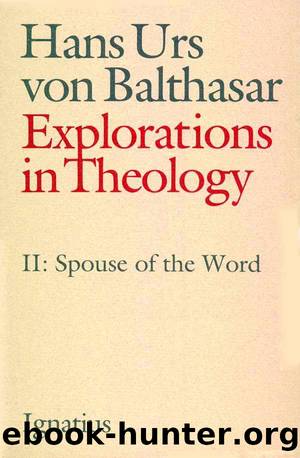Explorations in Theology II: . by Hans Urs von Balthasar

Author:Hans Urs von Balthasar [Balthasar, Hans Urs von]
Language: eng
Format: epub
Tags: Spiritual & Religion
ISBN: 9780898702668
Publisher: Ignatius Press
Published: 2011-11-17T05:00:00+00:00
8. The Babylon motif: the spirit of confusion
All the motifs and symbols discussed so far, even that of the archwhore Jerusalem, could be applied to the Church, because it was always possible to see her at the same time, in her essential core, as the immaculate bride. For the prophets, even Jerusalemâs rejection was one episode between her first and final eschatological election. But the picture is very different when we pass from the âarchwhore Jerusalemâ to the âarchwhore Babylonâ, an image that makes its first appearance in the Old Testament (Jer 50-51) and is then broadly unfolded in the New (Rev 17-19). Now, of course, the features of the two archwhores merge with one another in order to describe the character, crimes, and downfall of the terrible powers opposed to the Church. These not only play the whore, like Jerusalem, with all the mighty ones of this world but also intoxicate themselves with the blood of the martyrs, the children of the Church. In the Apocalypse, confusion between Babylon and the âbeloved cityâ is not even thinkable.
This ultimate irreconcilability of the spirit of Christâs true Church with the spirit of Babylon constantly led the heretics of the Middle Ages to identify the Roman Church with the great Babylon. The contrast expressed in this appelation, with its implication of an absolute reform of the Church that would alter her very essence, reduces all the different sects to their common denominator. âOne basic piece of evidence can be adduced . . . to support the view that medieval heresy originated in the widespread movement for Church reform and not primarily in a late resurgence of Gnosticism: the central importance that all the sects attribute to the question of the Church, and the arrogant, unbending opposition of all the heretics, from the eleventh century onward, to the Roman Church. All agree in recognizing her in the image of the great whore in the Apocalypse, in the Babylon of 1 Peter, in the Ecclesia malignantium or diaboli, who has falsified the pure evangelical Tradition. She is contrasted with the Ecclesia Dei, the only legitimate continuation of the apostolic Tradition through all persecution, all poverty, and all sufferingâ (Rafael Morghen).22 According to Stefano di Borbone, the Waldensians say, âThe Roman Church is the whore of Babylon, and those who obey her are damnedâ (Romanam Ecclesiam esse meretricem Babylon, et omnes ei oboedientes damnari),23 The apostolic brethren confess that âthere is a double Church, the spiritual and the carnal, the spiritual composed of those people who live in total poverty, the carnal of those who live in wealth and privilege. . . . It is this Church of which St. John speaks in the Apocalypse and which he calls Babylon.â24 Peter Dominicus, a Beghard, adds that âin the sixth phase of the Church, in which we now live, the Roman Church, under the name of âBabylonâ, has been cursed by Christ, rejected and destroyed, just as the old synagogue of the Jews was rejected by Christ.
Download
This site does not store any files on its server. We only index and link to content provided by other sites. Please contact the content providers to delete copyright contents if any and email us, we'll remove relevant links or contents immediately.
Christian Ethics for a Digital Society by Kate Ott(724)
Fearfully and Wonderfully Made by Philip Yancey & Paul Brand(705)
The World from 1450 To 1700 by Wills John E.;(657)
God and the Multiverse by Victor J. Stenger(616)
Numbers by Ronald B. Allen(578)
How to Read Slowly by James W. Sire(560)
Christian Ethics: An Introduction to Biblical Moral Reasoning by Wayne Grudem(558)
Morality by Jonathan Sacks(511)
Monastic Archaeology by Unknown(494)
The Technological System by Jacques Ellul(482)
The Disabled Church by Rebecca F. Spurrier;(470)
Jesus: A New Vision by Whitley Strieber(468)
Amish Grace by Donald B. Kraybill & Nolt Steven M. & Weaver-Zercher David L(466)
Children of Lucifer; The Origins of Modern Religious Satanism by Ruben van Luijk(458)
Death of the Doctor by Unknown(451)
Critical Writings by Joyce James;(450)
Redeeming Sociology by Vern S. Poythress(441)
The City of God by Saint Augustine & Marcus Dods(439)
The Church in the Early Middle Ages by G.R. Evans(421)
